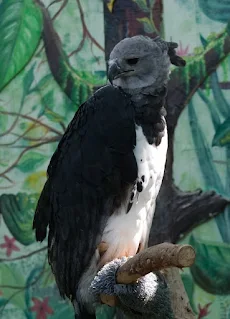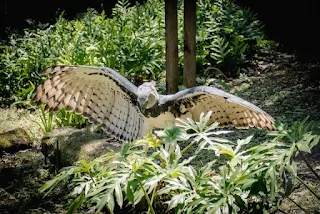Majestic Hunters of the Sky: The Harpy Eagle
Imagine a world where birds rule the skies with unparalleled majesty, soaring above the dense rainforests of Central and South America.
In this avian kingdom, one species stands out with regal grace and fierce prowess—the Harpy Eagle.
Let us go on an exhilarating journey as we look at the mysteries and marvels of these magnificent creatures.
The Harpy's Royal Crown: Anatomy and Appearance
 |
| Photo showcasing the harpy eagles striking feather colorations. |
Let's start our exploration with a visual feast—the striking appearance of the Harpy Eagle. Picture a bird that seems like it's stepped out of a mythological realm.
With a wingspan that can stretch up to 7 feet, these majestic raptors boast powerful bodies adorned with a distinct crown of feathers atop their heads.
This crown, resembling a regal headdress, adds to their regal aura.
Their feathers are a captivating blend of dark grays, blacks, and whites, perfectly adapted to the dappled sunlight of the thick rainforest canopy.
The Harpy's massive talons, each about the size of a grizzly bear's claws, are not just for show. They are lethal weapons, a crucial aspect of their predatory prowess.
Hunters of the Canopy: The Harpy's Habitat and Behavior
Now, let's delve into the Harpy Eagle's natural habitat—the verdant, lush rainforests of Central and South America.
These skilled hunters are the undisputed masters of the canopy, where they navigate with unparalleled agility. Picture them weaving through the intricate labyrinth of branches and foliage, their keen eyes scanning the surroundings for any signs of movement.
The Harpy's diet is as diverse as the rainforest itself. While their primary prey includes sloths and monkeys, they are not ones to shy away from a hearty meal of birds, reptiles, or even the occasional capybara.
Their impressive hunting skills and fearsome appearance make them apex predators, a testament to the delicate balance of nature within their ecosystems.
 |
| Photo of the dense jungle canopy where the Harpy loves to hunt. |
Family Matters: Harpy Eagles and Parenthood
Beyond their prowess as hunters, Harpy Eagles are also dedicated parents. Picture a family dynamic that rivals the most heartwarming scenes in the animal kingdom.
These raptors form monogamous bonds that last a lifetime, engaging in elaborate courtship rituals involving synchronized aerial displays and vocalizations.
Once a pair establishes a bond, they embark on a joint venture in parenting. Nesting in the tallest trees of the rainforest,
Harpies build colossal nests using sticks and branches. These nests can reach sizes that rival small cars, providing a secure haven for their offspring.
Typically, two eggs are laid by the female, and the parents invest a considerable amount of time and effort in nurturing their young.
Conservation Challenges: The Harpy Eagle's Battle for Survival
As we soak in the splendor of these magnificent birds, it's crucial to address the pressing issue of their conservation.
Despite their awe-inspiring presence, Harpy Eagles face numerous threats that jeopardize their existence in the wild.
Deforestation, a rampant issue in their native habitats, poses a significant challenge.
As human activities encroach upon the rainforest, the Harpy's natural home vanishes, leaving them with shrinking territories and limited prey.
Additionally, illegal poaching and capture for the exotic pet trade further exacerbate the challenges faced by these majestic creatures.
Efforts to conserve the Harpy Eagle involve a combination of habitat protection, community engagement, and education.
Conservationists work tirelessly to establish protected areas, educate local communities about the importance of these birds, and combat illegal wildlife trade.
By raising awareness and fostering a sense of responsibility, we can contribute to the survival of these incredible raptors.
Witnessing the Harpy Majesty: Conservation Tourism
Conservation tourism provides a unique opportunity for those who want to witness the Harpy Eagle's grandeur firsthand, a chance to venture into the heart of the rainforest, guided by experts who share their knowledge and passion for these magnificent creatures.
Conservation-focused ecotourism allows one to admire Harpies in their natural habitat and contributes directly to local conservation efforts.
Conclusion:
As we end our journey through the fascinating world of Harpy Eagles, let's take the chance to reflect on the importance of preserving the wonders of the natural world.
These majestic hunters of the sky embody the delicate balance of ecosystems and serve as ambassadors for the rich biodiversity of their rainforest homes.
In our joint efforts to conserve and protect, we can secure a future where the Harpy Eagle's majestic flight symbolizes the enduring beauty of the untamed wilderness.

Comments
Post a Comment